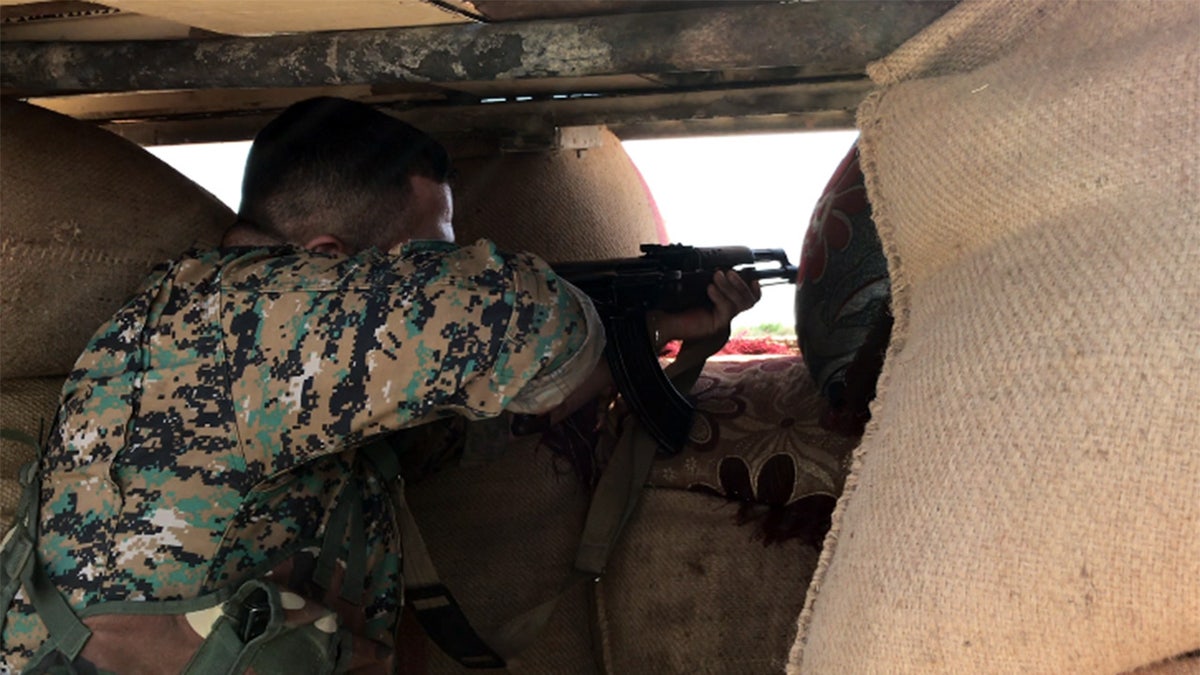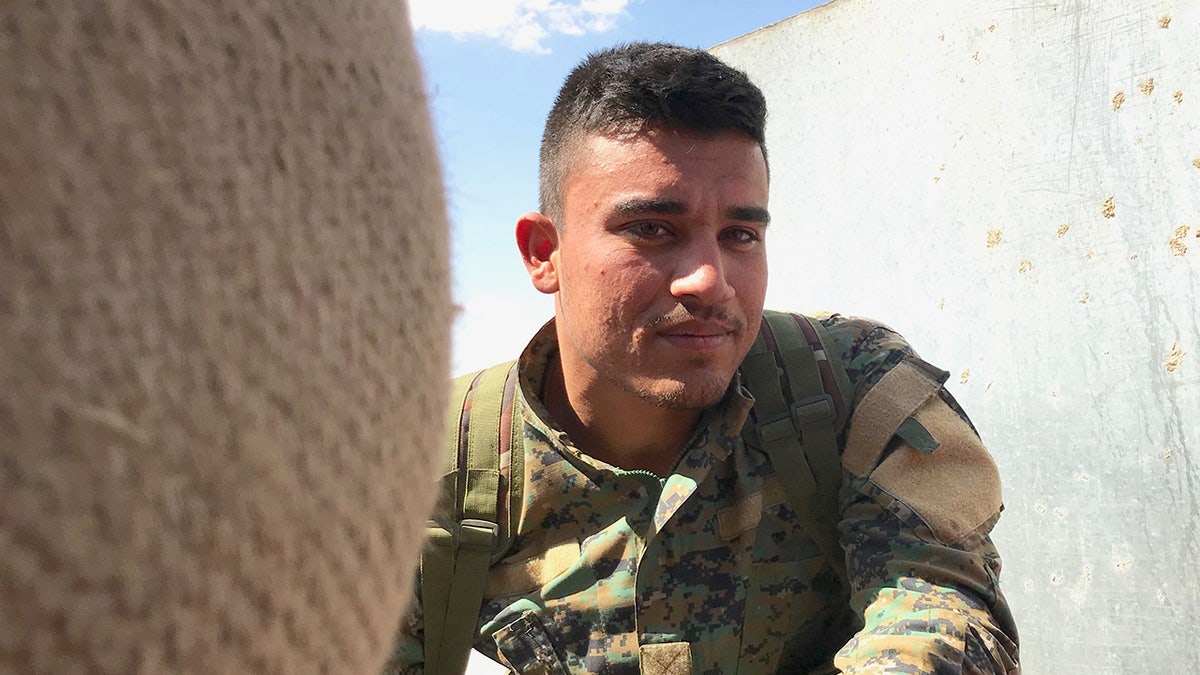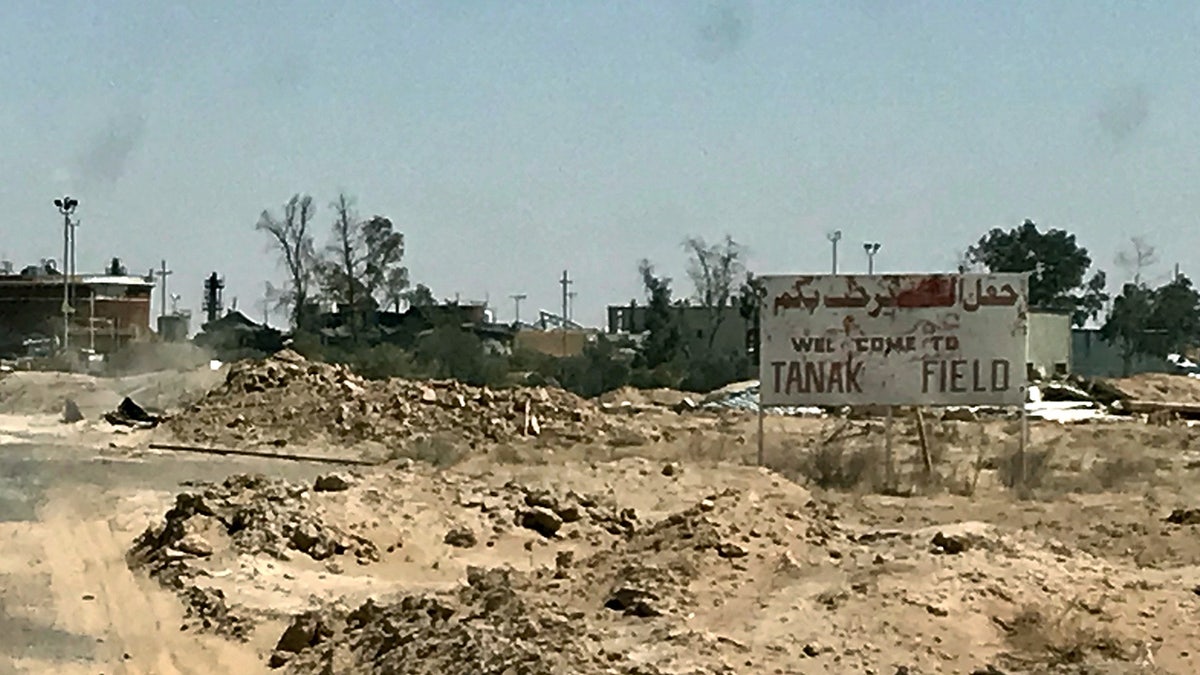
A soldier for the Syrian Democratic Forces at his post outside one of the remaining ISIS-held towns in Syria. (Fox News)
DEIR EZ-ZOR, Syria – The young soldiers of the U.S.-backed, Kurdish-led Syrian Democratic Forces (SDF) were scattered around the makeshift checkpoint, often sitting alone, veiled only by a ripped sheet.
They're positioned just about a half-mile outside the village of Hajin, in Eastern Syria, one of the few remaining areas that a beaten-back Islamic State (ISIS) force still controls.
“They still attack us every day, any time of the day,” said 21-year-old Hassan, the senior SDF soldier at the post. “Sometimes mortar, sometimes rockets. Always lots of bullets.”
Though ISIS has been defeated in more than 90 percent of the territory it once controlled in Iraq and Syria, removing this final pocket along the Iraqi-Syrian border -- including Hajin, on the eastern side of the Euphrates River, north of Abu Kamal; and Dashisha, west of Deir ez-Zor -- is proving to be a frustratingly slow process.
“This is their last territory, and thousands of them came here after Mosul and Raqqa,” Hassan said. “They are digging tunnels and planting mines all over.”
The push against ISIS came to a sudden halt in January, when Turkey launched its own operation, “Operation Olive Branch,” on the primarily Kurdish city of Afrin, near its border some 250 miles northwest.

"They (ISIS) still attack us every day, any time of the day,” said Hassan, a soldier for the SDF. “Sometimes mortar, sometimes rockets. Always lots of bullets." (Fox News)
“We didn’t want to fight here and lose Afrin,” said fellow SDF fighter Mihdi Khalil, 25. “The coalition wanted us to stay here, but Afrin was just as important to us to fight for; we decided to send many of our troops from here to there.”
The mission to defeat ISIS subsequently slowed, and gave rise to a diplomatic quagmire for the United States.
While the U.S. has backed the SDF as the primary and most trustworthy ground force against ISIS, NATO-ally Turkey views the group as an extension of the outlawed Kurdistan Workers Party (PKK), which has for more than 30 years waged a campaign specifically against the Turkish state.
U.S. officials stepped back from being dragged into the Afrin battle, which disappointed the SDF.
Turkish forces as well as their fighting partners, the Free Syrian Army (FSA), went on to seize Afrin from SDF control in March, dealing a blow to the SDF and pushing the "other" fight -- against ISIS -- into a state of limbo.
U.S. officials admit the Afrin campaign cost valuable SDF forces in the fight against ISIS, with as many as 1,700 troops being sent off by the SDF to fight the Turks.
“Since that departure, the SDF have been limited," Col. Ryan Dillon, spokesman for Operation Inherent Resolve (OIR), the name given to the U.S.-led coalition against ISIS, told Fox News. "When SDF was constantly putting pressure on ISIS in the two remaining locations, they were achieving success through ground forces/attacks.”
Dillon added that the U.S.-led coalition had launched airstrikes against ISIS forces, but relied largely on the SDF to provide the ground pressure. “Example: SDF attacks, we see ISIS react/move, we strike.”
With fewer SDF forces in action, Dillon said, U.S. military planners couldn't effectively target ISIS as they had before Afrin.
But new efforts are underway to get the mission back on track. Assets have been reallocated to gather more information on ISIS targets, and the pace of coalition strikes has quickened.
“This has allowed for the coalition to deliberately plan targets -- targets that can take days to weeks to develop -- before actually conducting the strikes,” said Dillon.
“ISIS remains an adaptive and savvy enemy that still poses a threat,” Dillon said. “They are largely in hiding, attempting to reconsolidate, and are planning what to do next: Either fight, surrender, or try to flee.”
ISIS has actually increased attacks in other areas of Syria, Dillon said, and it has even retaken some neighborhoods south of Damascus.
And for civilians still struggling to survive under the repressive rule of the Islamic State more than four years on, the waiting game -- and the suffering -- drags on.
“They are frightening the people, they behead people, explode bombs in markets,” said Mustafa Bali, an SDF spokesman. “They still create an atmosphere where it is impossible for people to escape from them.”
Those who try to escape ISIS-controlled territory face a potentially deadly challenge. An SDF medic on hand at the closest “emergency” clinic, 35-year-old Akif, told Fox News the slowing of the offensive has meant few military casualties -- but almost two dozen civilians injured by mines.
On Sunday, a 6-year-old girl lost a leg to a land mine, he said, and a few days earlier a young woman had her left foot blown off.
“Half of Hajin is under ISIS and the other half SDF,” Akif explained. “So ISIS plants a line of mines to protect themselves, and even if people just want to go to visit family or friends on the other side, it could be deadly.”
The SDF recognizes that Syrian government forces, distracted elsewhere, aren't doing much to help clear out ISIS. “The Syrian regime all these years has been too busy fighting people in Ghouta, they haven’t bothered with ISIS,” Akif said.
The burden has been a heavy one for the roughly 100,000-force SDF. Exhaustion is etched on young, sun-creased faces as the fighters shuffle between the front and the nearby Tanak oil fields. Some troops stay half a day on the firing line, others days on end. Almost all positioned there say they are no older than 21.

A bombed-out oil facility in eastern Syria serves as a base of operation against remaining ISIS forces. (Fox News)
Akif’s clinic is in the mangled Tanak oil facility, which was once one of the most prominent in Syria, and was a significant funding center for ISIS operations until they were run out in November.
But Tanak, along with several other prominent oil refineries clustered in the area was decimated last year by Syrian and Russian regime warplanes. Only one well currently works, SDF soldiers said.
And the ISIS danger still lurks. Suicide bombers still intermittently hit the area, and concerns over sleeper cells has meant the immediate area has a curfew of 3 p.m. The surrounding stretch, reaching to the village of Shadadi, around 75 miles away, has a cutoff of around 7 p.m.
“Any cars moving through after that,” one soldier said, “we shoot.”
Hassan insisted the SDF is “very well equipped” for the much-anticipated final takedown against ISIS -- with U.S.-supplied rifles, rocket-propelled grenades, and Russian machine guns and missiles at the ready.
“We are waiting our orders,” Hassan added. “When they tell us to move in, we will destroy them.”
